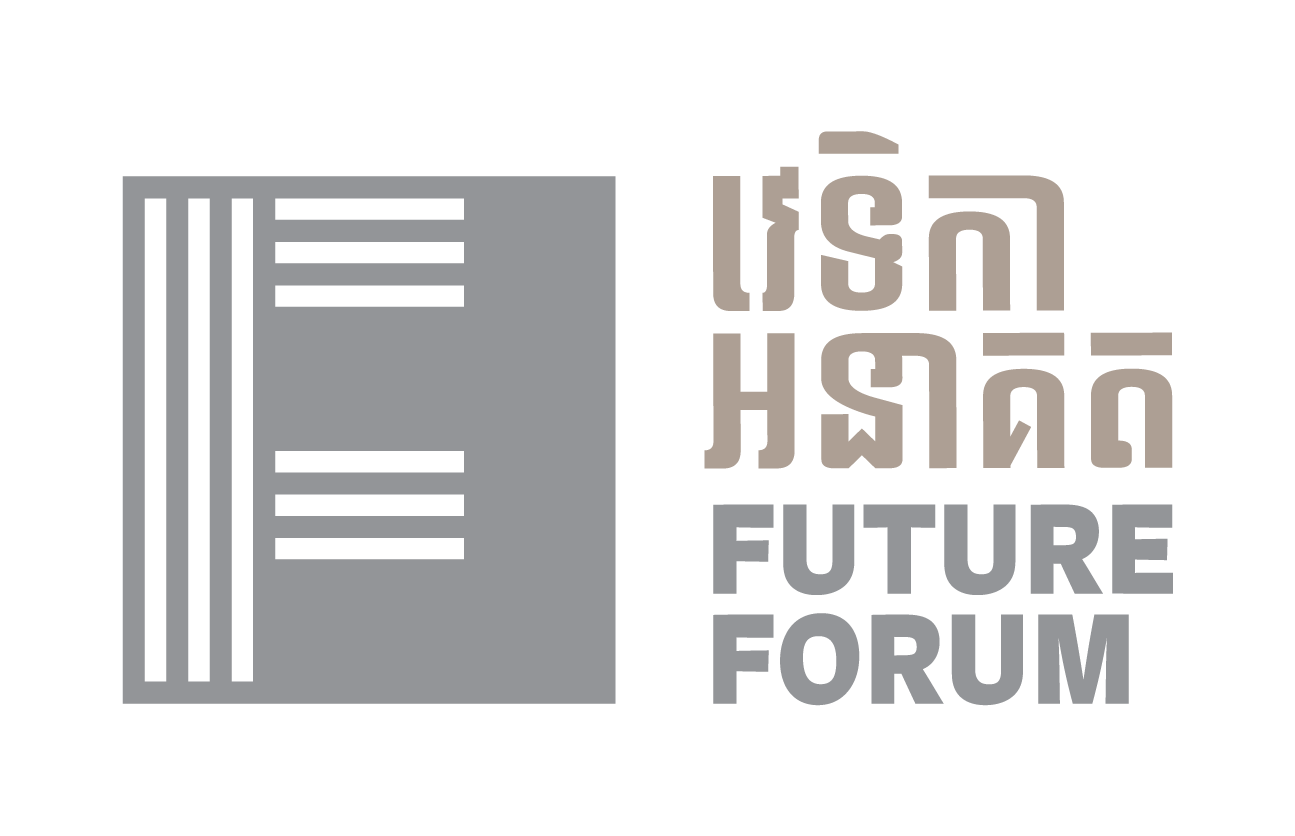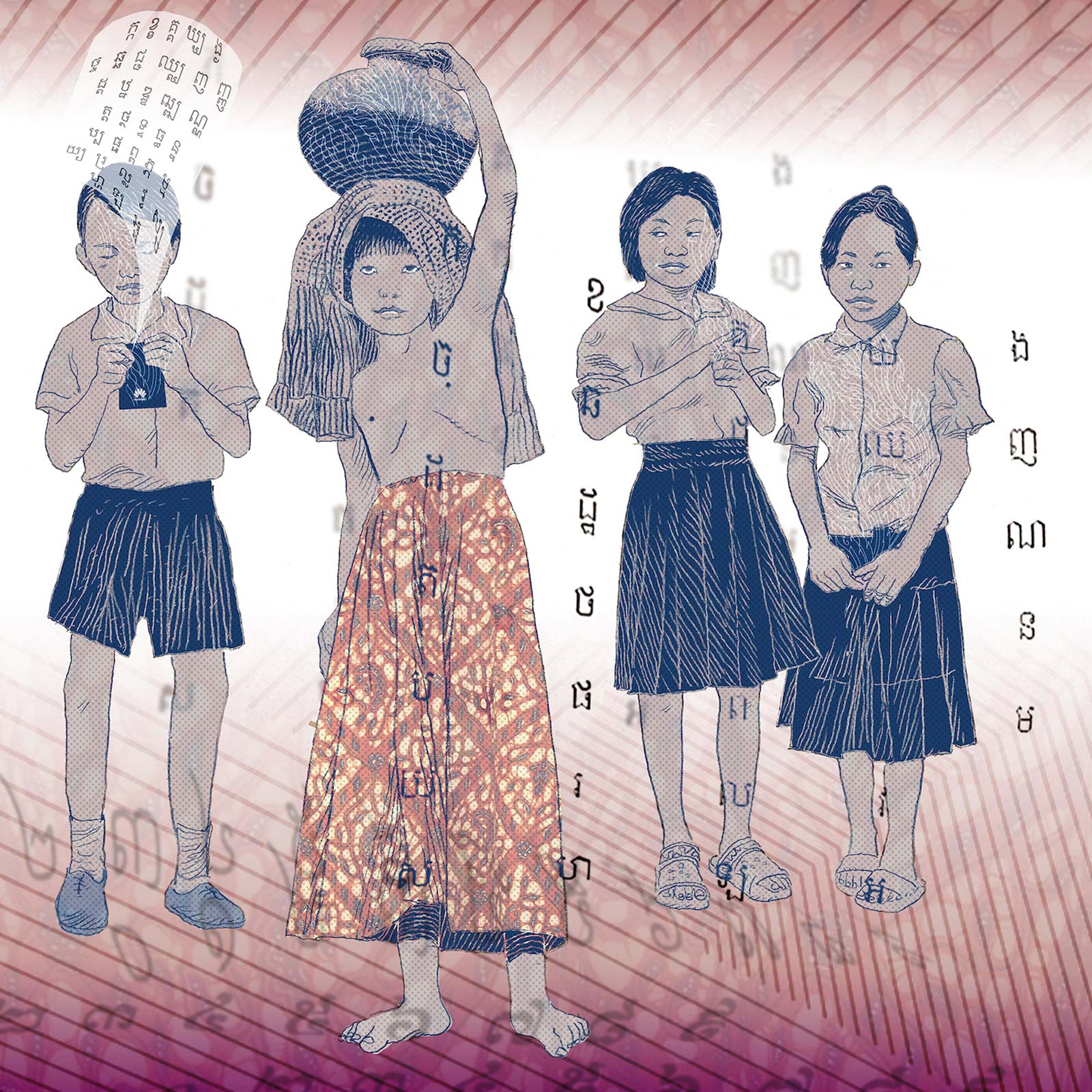Illustration by Séra
The year is 2040. It’s 8am on a Monday morning in the Cambodian capital Phnom Penh, where Mongkol, an 11-year-old boy, is eating his breakfast and listening to a science podcast. Soon the school day will begin.
Mongkol takes the driverless bus to public school, looking out at the quiet roads following the successful implementation of a city-wide public transport system back in 2030. Long before his time, Mongkol heard these streets were brimming with motorbikes and tuk-tuks that contributed to an environmental crisis.
The facial recognition scanner beeps in acknowledgement of Mongkol’s attendance as he arrives at school. He’s excited – the semester has only just begun and Mongkol, now in Grade 6, has picked out the subjects he wants to specialise in. First lesson of the day – history, and his classroom instructor fires up a hologram of Angkor Wat that has been developed by a Grade 12 class. Taking notes on his tablet, Mongkol marvels at the architectural intricacy of this ancient structure and wonders how it has survived for so long.
Just as the class is ending, the instructor reminds all students to log into the online Learning Management System to see feedback on their last history assessment. Although Mongkol is confident he performed well on the test – history is his favourite subject after all – the familiar rush of nervousness envelopes him as he heads for the canteen.
Joining his friends Mony and Dara, Mongkol collects his pre-ordered lunch and the three discuss the upcoming project they will work on together. As part of the special education class for visually impaired students, Mongkol, Mony and Dara are designing a personal assistant robot for the elderly in the school’s tech and innovation lab. Although the details of their project are yet to be finalised, the need for utilising tech to assist their grandparents is painfully clear to them.

With the school day coming to an end around 4pm, Mongkol walks through the city to the nearest sky-train station. Built some 12 years ago by Japanese and Cambodian engineers, the sky-train gives Mongkol a peaceful voyage home and a chance to pick up where he left off on his podcast.
This is the vision of Cambodia’s education sector set out by think-tank Future Forum as part of their Cambodia 2040 project – a collection of essays that outline best-case scenarios for the Kingdom in two decades’ time.
But to arrive at this vision from Cambodia’s current baseline will be a process that is neither easy or fast.
Learning to leapfrog
Education has long been a stumbling block for Cambodia, a nation that wears the scars of its brutal recent past on its sleeve.
When the Khmer Rouge in the mid-1970s set about systematically murdering those even resembling an intellectual – including wearing glasses – they condemned the Kingdom to a long game of catch-up in cultivating a new generation of bright minds.
Some may argue that it is impossible for a low-performing country in human capital development like Cambodia to catch up with high-performing countries in 20 years. But with a realistic dream and a clear action plan … Cambodia can leapfrog to achieve the desired vision
Theara Khuon, a programme manager for education and training at Future Forum
Fast forward to 2020, and while very real and tangible progress has been made in the education sector, there are challenges that must be overcome if Cambodia is to meet Future Forum’s vision of 2040.
“Some may argue that it is impossible for a low-performing country in human capital development like Cambodia to catch up with high-performing countries in 20 years. But with a realistic dream and a clear action plan capitalising on the predicted possibility, Cambodia can leapfrog to achieve the desired vision,” writes Theara Khuon, a programme manager for education and training at Future Forum, and an essay-contributor for the Cambodia 2040 project.
Although Khuon recognises the potential for Cambodia to employ emerging technologies and explore new approaches to learning, he is also aware of the innumerate problems currently facing the Kingdom’s education system.
The Programme for International Student Assessment (PISA) is the education evaluative body of the Organisation for Economic Cooperation and Development (OECD), and in 2018 it produced a report that painted a dire picture of Cambodia’s education system.
Just 8% of Cambodian students achieve the international minimum proficiency in reading and only 10% meet minimum standards in maths. Some 7.5% of students reported having missed school for more than three consecutive months, less than half of students surveyed reported having regular conversations about their academic progress with parents and only 28% of the population attained Grade 7 education by the age of 15 in 2017.
It also found that in 2018 Cambodia spent just 2.7% of GDP on education, fairing poorly compared to neighbouring Vietnam whose GDP spending on education went from 4.3% in 2016 to 5.8% in 2019.

Addressing a crowd in Phnom Penh at a recent World Bank event on the future of work, Deon Filmer – a specialist in human capital – noted that schooling, which Cambodia had greatly improved upon over the course of a decade, was not the same as learning.
“In Cambodia, in the Grade 6 National Assessment of 2016, sixth graders were assessed in maths and Khmer. In maths, almost 60% or 50% scored below basic. Below basic is the bare, bare, barest minimum. Basic isn’t even proficient, just 30 to 40% of kids in Grade 6 scored what could be considered proficient.
“By Grade 11 the picture doesn’t look much better,” he said, adding that even the highest scores achieved in Cambodia were well below the average in other countries.
Filmer identifies several dimensions to what he calls Cambodia’s learning crisis, citing a low ratio of learning to schooling, sluggish growth within the education sector and high levels of inequality.
Urban/rural divide
Reinforcing this was PISA’s revelation that urban students outperformed their rural counterparts in reading by 42 points – the equivalent of half a year of schooling. In short, advantaged students, usually in major cities, were four times more likely to attain a baseline proficiency in maths than underprivileged students, usually in rural areas.
This divide between urban and rural students is festering at the heart of the Cambodian education system – and is further compounded by a division between public and private institutions – with the end result a widening gap between rich and poor students.
It’s remarkably difficult to separate the two issues – rural vs. urban students and public vs. private students – as data from the Ministry of Education, Youth and Sports (MOEYS) shows. Khamboly Dy, MOEYS spokesman, provided numbers to Southeast Asia Globe that perfectly illustrate the complexities of the Cambodian education system.
I think technology is an effective way to address the rural-urban divide in terms of equitable access to quality education. Most of the qualified teachers, they are in towns, in Phnom Penh, and not many of them want to go into rural areas
Theara Khuon, a programme manager for education and training at Future Forum
For the 2018-19 academic year, there were 218,357 students enrolled in 1222 private schools in Cambodia, but the vast majority of the schools – 994 in fact – were based in urban areas. The 182,846 students studying at private schools in urban areas dwarfed their rural counterparts, who comprised just 35,511 students in 228 private institutions.
Contrast this with public schools and a two-tiered education system becomes apparent. Of the 3,189,172 students enrolled in Cambodia’s public schools for the same academic year, 2,594,258 were enrolled across 11,878 rural schools, while the remaining 600,000 or so were enrolled in 1422 urban public schools.
What Dy’s data shows is the growing divide between rich and poor, intrinsically linked to Cambodia’s urban and rural communities.
“The education system itself is unequal,” admits Khuon.
But he adds that technology is a means to levelling the playing field through blended and distance learning.
“I think that’s [technology] an effective way to address the rural-urban divide in terms of equitable access to quality education. At the moment, most of the qualified teachers, they are in towns, in Phnom Penh, and not many of them want to go into rural areas, so that is one of the explanatory factors. Why the quality of education in rural areas is not there is a big problem, but with technologies I think it would get much better,” he says.
Khuon cites the wealth of academic material that has been made available to the public since the advent of the internet, with websites such as Coursera, edX and Utopia Education and Art offering numerous educational resources. However, only a very limited amount are in the Khmer language.
“A lot of platforms have been created and I don’t think we have fully tapped into the true utility of them, especially in the context of Cambodia,” he adds.
He suggests that the MOEYS needs to systematically develop these online resources to enhance the educational opportunities of rural and disadvantaged students if the Kingdom is expected to meet Future Forum’s vision of Cambodia in 2040.
Cambodia’s technological limitations are not lost on Khuon, and while he hopes that inequality can be curbed through the introduction of online resources, he is well aware of the need for an inter-ministerial approach to address this.
“There are constraints to this solution – first is the internet connection; we need a high-quality internet connection and that is not there in most rural areas at the moment. This is the task of the Ministry of Posts and Telecoms to push that forward. But if this materialises, half of the puzzle is solved,” reasons Khuon.

He goes on to note that solving the other half of the puzzle is the affordability of technology. Computers, tablets, 3-D printers – he hopes – will become more affordable, following the same trajectory as mobile phones since their explosion in the 1990s.
“We need to think about how to connect the internet with existing and potential educational devices and technologies in a classroom setting and how to make them accessible for both rural areas and urban areas. I think if this happened, the inequality will diminish on its own naturally,” suggests Khuon.
One of many challenges
This is but one of the many challenges Cambodia’s education system must rise to in order to meet Future Forum’s vision for 2040. Tackling them all requires a holistic approach, suggests Setha Rath, the author of another education-focused chapter in the Cambodia 2040 project.
“Cambodia should, first and foremost: invest in public education and human resource development through the competitive recruitment, retention and capacity building of educators; prioritise STEM education; replicate the New Generation Schools (NGS) model; ensure access to education is inclusive of children with disabilities and those from disadvantaged backgrounds, with the necessary support systems in place; develop sustainable public and private partnerships; and design technologies that respond to the needs of both students and educators,” she says.
She adds that last year’s budget for education was raised 7.32% from 2018 to $915 million, but with so many areas in need of intervention, it’s hard to know where to begin.
For Ashley Irving – a long-serving principal at the Australian Centre for Education in Phnom Penh – human resources are the best resources available.
“Here [Cambodia] I see massive potential and I see massive problems, but without the human resources, who’s going to teach the kids? For me, everything else is an additional resource; the technology, the classrooms, all these things – the investment has to be in human resources, in the teachers because in Cambodia it’s still challenging to find good teachers, although that is changing,” he argues.
Irving explains that tech could play a role in improving teacher training, but that the real change needs to come in the form of incentivising and professionalising teachers. This, both Irving and Rath agree, firstly must focus on salaries.
It pains me to see the most talented students only looking to universities for their future. In a country like Cambodia – in the current global economy that we live in now, with the technological landscape and the future of work – to send a whole generation into an antiquated system, the global university system … is a massive waste of resources
Allen Tan, founder of STEM Cambodia
“If you compare teaching to the salaries on offer in the private sector or through NGOs, there’s just such a big gap in earning potential,” says Rath.
A large feature of both Rath and Khuon’s essays is the need for Cambodia to realign national education with the needs of the future labour market. For this, both the Future Forum authors strongly recommend a greater focus on STEM subjects – science, technology, engineering and maths – at all levels of the education system.
Founder of STEM Cambodia and prominent businessman, Allen Tan, has been working for five years to promote awareness of STEM subjects. Born out of a white paper written by Tan and approved by Minister for Education Hang Chuon Naron, STEM Cambodia has become an annual festival celebrating STEM subjects, with over 30,000 students attending last year.

“A focus on universities will kill the future of this country. It pains me to see the most talented students only looking to universities for their future. In a country like Cambodia – in the current global economy that we live in now, with the technological landscape and the future of work – to send a whole generation into an antiquated system, the global university system … is a massive waste of resources,” contends Tan, who sees a push towards STEM as a way to bridge the skills gap that Cambodia currently suffers.
“In five to 10 years from now, Cambodia could be Southeast Asia’s powerhouse for tech, it could be the leader – this is not impossible, but it’s irresponsible to continue a narrative that says then your child can only be successful if they go to university, when we know very well, that when they do that is not going to make them more successful … especially in Cambodia, where the economy really needs tradespeople,” he says.
By many accounts, minister Chuon Naron is indeed the man of vision that Cambodia’s education system needs, and is widely credited with stamping out the corruption associated with public schools since his first mandate began in 2014.
But the question of whether he alone will be enough to make Future Forum’s vision of 2040 a reality remains to be seen and the issues facing the education sector continue to pile up.
This article has been researched and written in partnership with Future Forum, in the lead up to Future Forum’s upcoming Cambodia 2040 book launch. Find out more here.



